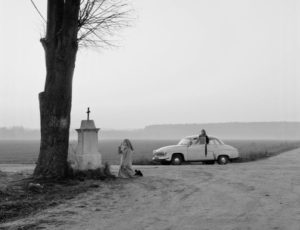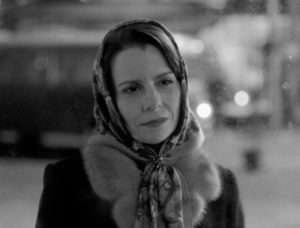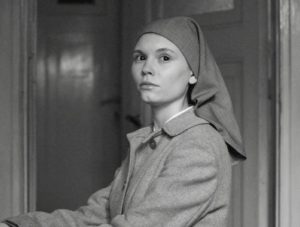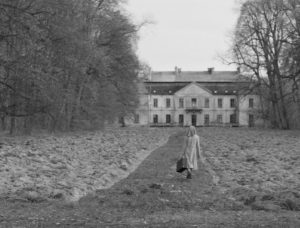Ida (2013). Directed by Pawel Pawlikowski. Co-written by Pawel Pawlikowski and Rebecca Lenkiewicz. Starring Agata Kulesza and Agata Trzebuchowska. PG-13. 82 mins. Rotten Tomatoes 96%; Metacritic 91%.
A young Polish novice, Ida (Agata Trzebuchowska), a WW II orphan raised in a convent, is summoned by the Abbess with the instruction to visit an aunt she never knew she had. So off she goes to the city to visit Aunt Wanda, a relatively well-to-do and well-known former Communist prosecutor (Agata Kuslesza, who also plays the Mother Superior in The Innocents [2016], another tale of Polish nuns). The would-be nun exudes innocence and virtue whereby the aunt is quite the opposite, a world-weary chain-smoking alcoholic who sleeps around and who, back when, never seriously considered raising her orphaned niece. Instead, Wanda became known as Polish Marxism’s “Red Wanda” for her merciless prosecution of political opposition, sending many to death for mere dissent (writer-director Pawlikowski knew such a person when studying at Oxford).
No sooner do aunt and niece meet than Wanda informs Ida that she is in fact Jewish, a reality that her Christian keepers never divulged, if indeed they knew it themselves (as an infant she was handed over to a priest by a young farmer who murdered the rest of her family in order to obtain their farm; his father, on the other hand, had hid and protected them). Now, in the early 1960s in grimly Marxist Poland, the two venture a quest to find out what happened to their family in the early days of WWII and what that information means for them personally. What follows is full of surprises both sad and happy.
Winner of Best Foreign Film from both BAFTA and the Oscars, and spoken of by eminent critics as a masterpiece, Ida (2013) both startles and haunts. Polish-born British writer-director Pawel Pawlikowski tells his story very simply, and compellingly, in black-and-white and with a peculiar verticality to screen ratio, the film has a strange sort of power. The New York Times’ A. O. Scott, an insightful and eloquent film critic, even suggests that the settings, filmed as they are, “often achieve a quiet grandeur, an intimation of divine presence.” That said, the history Wanda and Ida uncover prods radical decisions.

That said, it is the wrenching story that occupies, as well it should, the viewer. As for Wanda, thoroughly disillusioned, and probably carrying enormous guilt, the only things that seem to keep her moving are the occasional tryst and what she imbibes from classical music, which she plays whenever she can. Though finally, knowing what she now does about human cravenness, her own and others, hounds her, and she makes a radical choice, one that is extreme but also understandable, given her personal history and what she discovers. Post-war Poland, though going through a sort of “thaw” in the early 60s, is still a conspicuously grim place.

Though she is markedly younger and radically inexperienced in “the world,” innocent Ida must test life on the “outside,” and she puts off taking her final vows. When away from the convent attending to family matters, she meets and romances a kindly and very handsome young jazz musician (Dawid Ogrodnik). And while he loves the “freedom” of jazz, he sees nothing more to the rest of life than sort of going through the empty motions of conventional bourgeois expectations: love, marriage, kids, and conventionality.

Just as classical music could not finally sustain her Aunt Wanda, Ida detects a similar insufficiency within the brooding, searching beauty of jazz. Indeed, having tasted romance and passion, and heard her jazz-musician lover’s rendition of a stolidly bourgeois life to come (not all that different from the capitalist West), Ida also makes a startling choice, one no less surprising and radical than her aunt’s.
Indeed, what follows shatters most viewers’ expectations because it challenges the gist of modern culture as a whole. Indeed, Ida flips the usual narrative, for early one morning Ida leaves her lover’s arms to don again her habit to return “home” to take her vows. The predictable intellectualist shibboleth has for long deemed just about anything as more liberating or fulfilling or whatever than “religion,” let alone life in a convent, especially for the young, attractive, and thoughtful, for those, in short, like Ida. Pawlikowski has it another way: politics and art, well, markedly redemptive they apparently are not, at least in this setting, either socially or personally. So Ida hearkens to a different drummer of a quite different music in the universe (oddly, music in the film is sparse, though it “tells” plenty when it does, the film concluding with an achingly beautiful piano adaptation of Bach, BMV 639).
Ida’s choice is especially telling since the film does not in the least mince, romanticize, or prettify convent life. Indeed, life portrayed there looks even grimmer than life on the “outside,” an existence of solitude, silence, scarcity, and submission. Still, having tasted the “pleasures” of liberation, Ida opts for, good heavens, something like sanctity, for lack of a better term: self-sacrifice and deprivation, to be sure, but also, and primarily, devotion to God and others.

Pervading this quiet saga of two very different souls, the film’s staging and cinematography suggest that some sort of numinous Something abides in the spare conditions and regimen of life in the convent. Indeed, the film partakes, mysteriously, of the sparse cinematic means heralded by Robert Bresson and Paul Schrader (see Schrader’s book Transcendental Style in Film as well as his new film, First Reformed, due for release in early 2018). Often, less is more insofar as it strips away the clutter to show reveal Light itself within the bare rudiments of being, meaning, of course, in other words, divine love for humankind (grace).
That is nowhere more apparent in the film than with its patient, largely immobile camera and its insistent verticality that by the end of the film strangely begins to feel cruciform (that may be a gross misreading on my part, but that is the “feel” of it, even for one who tends to scorn too-easy Jesus figures and cinema’s usually trite renderings of the holy). Sometimes a picture really is worth a thousand words–if any number of words can even get to it (think Rembrandt, Vermeer, and Money)—becoming in effect a sort of visual parable of all that matters and the route to it. So it is that by the film’s end, that Ida, again quoting Scott, becomes at once “austere and charged,” full of a quiet “intensity that verges on the metaphysical.” And then some.
Sign Up for Our Newsletter!
Insights on preaching and sermon ideas, straight to your inbox. Delivered Weekly!
Categorized into God, Piety
Ida (2013)